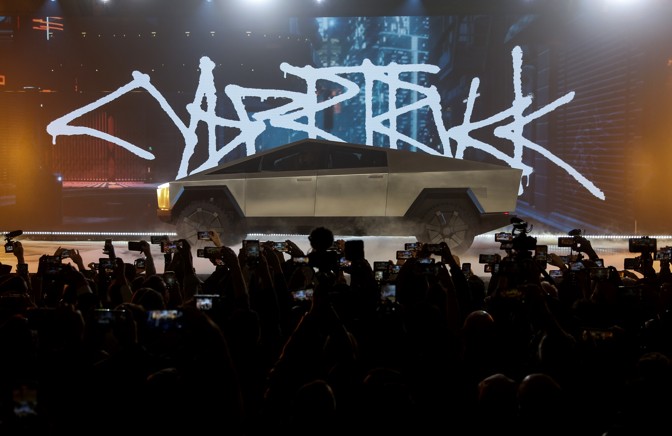If you attended an American elementary school since the end of the last century, you have probably seen an icon called “Cool S.” (That is really its name.) It is basically what it sounds like: the 19th letter of the alphabet, rendered so as to be maximally appealing to the Billabong set. Its native habitats include the walls of laser-park bathrooms, the margins of math textbooks, and the forearms of 9-year-old boys. Justice Potter Stewart is remembered today for the phrase “I know it when I see it”—which happens to describe the “Cool S” well—but had he attended elementary school in Cincinnati roughly 70 years after he actually did, he would instead be remembered for writing his name “Potter S.,” with the Cool S, at the top of every assignment.
Anyway, it looks like this:

This has been a historic week for the Cool S, because it is the unacknowledged but undeniable inspiration for Tesla’s new pickup, the Cybertruck. (That is really its name.) It looks like this:

The influence of the “Cool S” is indisputable. You will notice several other unorthodox design choices: The truck is made of stainless steel, and does not have sideview mirrors. It does not have shatter-proof windows, also. Take down the mighty atlas of aesthetics from its high shelf, and you will find that a thin border separates machismo and self-parody, bravery and priapism. But you will not find the Cybertruck, because it is entirely off the map, floating half-submerged in an ocean somewhere.
The truck was announced via livestream Thursday night, and of course Twitter immediately attacked: Here was a chonky new target for its free-wheeling scorn. Katherine Miller of BuzzFeed correctly observed that it looked like a vehicle from the video game Golden Eye on N64, “back before they could really make people look like people and cars like cars.” And my colleague Ian Bogost noted that the Cybertruck “fully realizes” the design taste of Tesla’s chief executive, Elon Musk: “It is 12-year-old boy’s loose-leaf notebook sketches.”
It is a very silly truck. (It also may not be a normal-sized pickup: Of all the photos released so far, few actually show the size of its bed.) But I also wonder, reading the commentary, how many people have seen other new trucks. Have you looked at new car designs lately? Half of them look like a Yeti cooler mated with a lamprey. Most car commercials now end with a shot of their “lineup,” which is to say, eight crossovers distinguished only by how much their grilles are yawning. In 2017, construction crews in London removed a fatberg—“a 130-ton mass of sanitary products and cooking fat”—from the city’s aging sewage system. A small amount of the fatberg was put on display in a museum, but the rest was secretly injected with human growth hormone and turned into the Infiniti QX80.
What I’m saying is, at least the Cybertruck looks different.
And while Musk has a habit of promising a lowest tier of prices that never actually arrive, the Cybertruck seems like it will be priced competitively: $39,000 to $69,000. That places it in the same approximate range as other pickup trucks, which are America’s best-selling and most profitable vehicle segment. While Tesla’s margins probably won’t be as padded by pickups as Ford and General Motors’ are, this is arguably the first time the company will compete with mainstream brands at a mainstream price. Pickup buyers are used to paying nearly $50,000 for a new truck; the Cybertruck (that is still really its name) is safely in that margin. It will also be competitively priced with the first electric pickup from Rivian, a new automaker that can count both Ford and Amazon as investors. Rivian’s first vehicle, the R1T, is due to beat the Cybertruck to market by a year, but its entry-level model starts at $69,000.
When it goes on sale, it will represent a sort of triumph for Musk. While Musk’s business record is somewhat mixed, his approach to decarbonizing the economy remains underrated. Instead of fretting that climate-friendly electric vehicles are not yet cost-competitive with their gasoline-burning rivals, Musk figured out that he could underwrite their higher prices through luxury margins. Hence his decision to build a Tesla sports car before anything else.
It’s true that in the sedan segment, he has not achieved his goal of a long-range electric vehicle that costs less than $35,000. But Tesla’s trucks do not need to stoop to that target. It is now likely that, in the fall of 2021, America’s best-selling segment will include an electric vehicle that’s competitive on price. Congratulations, Mr. Musk. Now, please stop doodling and learn about parabolas.
from Technology | The Atlantic https://ift.tt/2qGgWCZ
